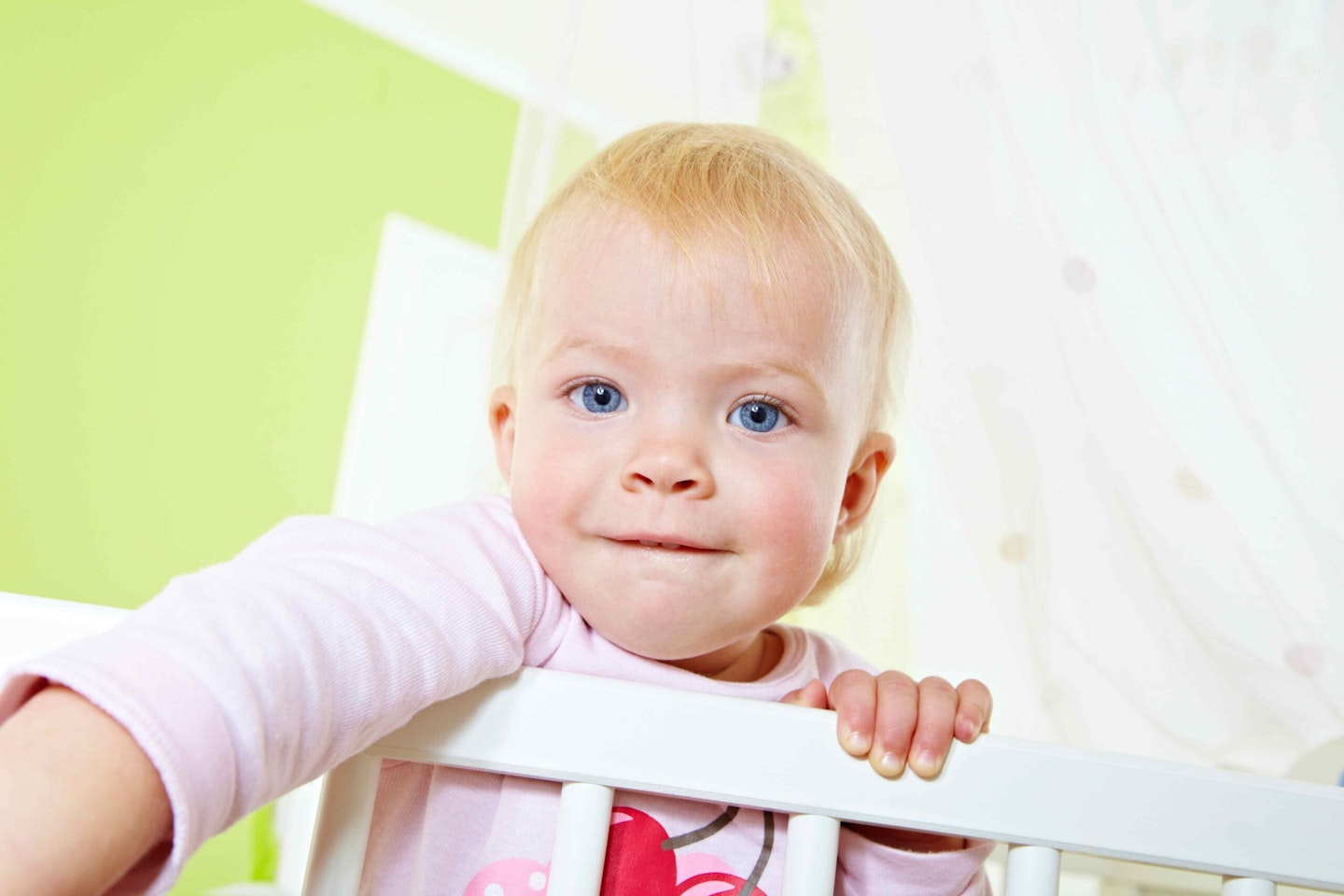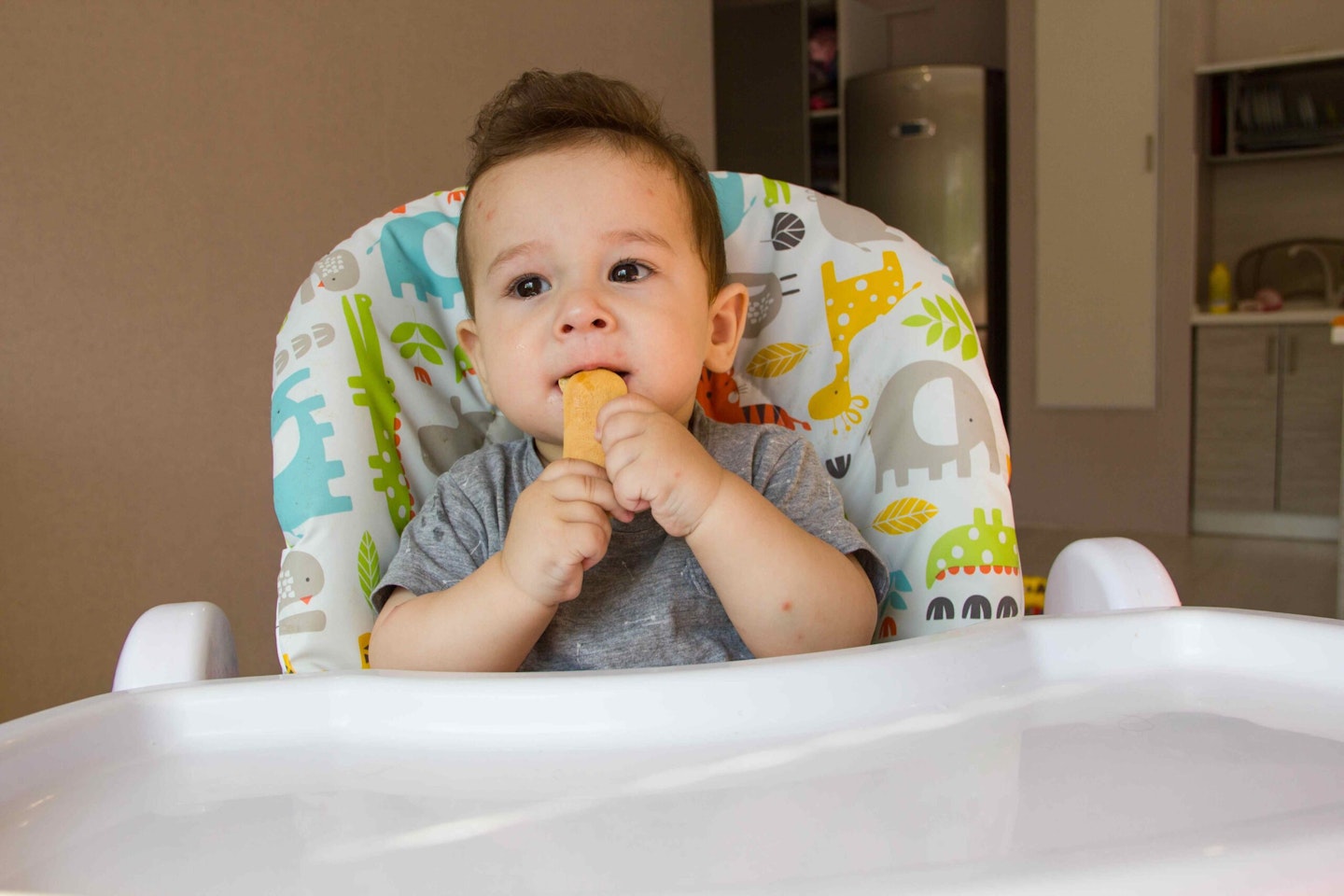Your baby has turned 10-months old and there's so much happening! They are more active, alert and sociable than ever before. Your baby may not be talking just yet, but they are no doubt finding other ways to communicate with you by waving, pointing their fingers, shaking and nodding their heads. Your baby might be pulling themselves up on the furniture now and cruising around, getting ready to take those first, unaided steps.
With so much going on in their little busy brains and so many firsts to experience you might notice your baby starting to resist naps and bedtimes. A great way to deal with this is to have an age-appropriate sleep schedule in place, so that you know exactly how many hours sleep your baby needs, at their age, both during the day and at night.

Make sure you're aware of wake windows for 10-month-old babies so that they are not going too long in between sleeps and becoming overtired. Not leaving enough time in between sleeps can also make nap and bedtimes difficult, as your baby may not be tired enough to drift off.
I'm Jo Smith, a trained baby sleep specialist, mother of three and founder of Jo So Sleepy and I've developed an easy to follow sleep schedule for 10-month-old babies below. You may want to alter the timings to better suit you, but this plan gives you a clear idea of exactly how many naps your 10-month-old should have, how long the naps should be and how long they should be awake in between naps.
I've also included some useful sleep tips for 10-month-old babies and some simple, but fun, daytime activities that will help your baby sleep better at night.

10-month-old sleep and feed schedule
7am - Awake and breakfast (awake for 1 hour 45 mins)
8.45am - Wind down time/small feed if needed
9.15am - Nap 1 (1 hour)
10.15am – Awake (2 hours)
11am - Feed lunch
11.45am - Wind down time and top up feed
12.15pm - Nap 2 (2 hours)
2.15pm - Awake and snack (awake for 4 hours)
5pm - Dinner
5.30pm - Bath, calm down time and ready for bed
6.15pm - Feed
6.30pm - Bedtime
How much sleep does a 10-month-old baby need?
In general a 10-month-old baby should have around 13.5 hours of sleep over the course of 24 hours. This should be made up of 3 hours of naps per day and 10.5 hours of sleep at night-time. However, every baby is different and their needs can vary too. These figures are just averages and should be used a general guide.

What are the wake windows for 10-month-old babies?
Typically the wake windows for 10-month-old babies are between 2-4 hours. Their first nap of the day should be 2 to 2.5 hours after waking up. They will typically need 2 hours of awake time before nap number 2, and 4 hours of awake time before bedtime.
Is there a 10-month sleep regression?
Sleep regression, as a term, simply means a period of time where your baby is struggling to sleep. It doesn't mean you've done anything wrong or that your baby is 'regressing' in any way. This may not be the first time you’ve experienced a sleep regression as the common ages for this are four-months and 8-months-old. These are nearly always linked to major developmental milestones like crawling or standing.
Some parents report that as soon as their baby can pull themselves into a standing or sitting position in their cot they start doing this at naptime and sometimes in the night. One way to avoid this is to timetable some relaxing wind down time just before bed. Try reading books, giving baby a gentle massage or listening to relaxing lullabies.
Another reason for sleep struggles at this age is that your baby may experience separation anxiety which can cause increased wakefulness. My advice is not to ignore them but to wait a few minutes to see if they settle, if not, go in and reassure them that you're nearby, offering gentle comfort to help them drift back off.
So, while 10-month is not usually an age associated with a sleep regression babies can experience these at any time, depending on their rate of development.
Can a 10-month-old baby sleep through the night?
Yes, many parents report that their 10-month-old babies are able to sleep through the night independently without fully waking until the morning. This is much more likely if your baby is able to fall asleep independently, without the need of rocking, stroking or feeding to sleep. Babies who are well-fed throughout the day are also more likely to sleep better and not wake for feeds. However, not every baby is the same and some may still need one or two night feeds at this age so go with your own baby's needs.

Why does my 10-month-old baby keep waking at night?
As mentioned above, your baby could be going through a sleep regression which is throwing their usual slumber schedule off. At 10-month separation anxiety starts to kick in and your baby is much more aware when you are not present. These issues should only last a few weeks, so stick to your schedule as best you can and offer gentle comfort when they need it as well as encouraging them to self-soothe.
These aren't the only reasons that your baby could be waking more frequently, start by checking their gums to see if they are teething. If their cheeks are flushed and they are tugging at their ears this is sure sign that some new teeth are coming through and you should help alleviate the discomfort with medicine.
Acid reflux is another reason that some babies wake up. Look out for signs such as; being sick after feeding, coughing or hiccuping during feeding, arching their back and turning their head when feeding and being noticeably irritable after feeding. If you think your baby has acid reflux speak to your doctor or health professional about treatments.
If your baby is still not sleeping well after 6 weeks or more then I would consider getting help from a baby sleep specialist.
Top sleep tips for 10-month-old babies
Encourage self-soothing
Most 10-month-old babies will now be developmentally able to fall asleep independently so if you have been rocking or feeding them to sleep now’s the time to try and transition to allow them to fall asleep on their own. Relying on methods like feeding or rocking to sleep can create bad habits that are hard to break as children grow older.
Create a consistent bedtime routine
Establishing a calming, predictable bedtime routine helps signal to your baby that sleep is coming. Simple activities like a warm bath, gentle massage, pyjamas, a lullaby, or reading can ease them into sleep - this shouldn't be too long, 45 minutes maximum.
Follow age-appropriate wake windows
Staying within these wake windows (see above) helps prevent overtiredness, which can lead to difficulty settling down and more night wakings.
Darken the room for naps and nighttime sleep
A dark room can help your baby sleep longer, as it encourages the release of melatonin, a sleep hormone. Blackout curtains or shades can be useful for blocking out light, especially during the longer days.
Avoid overstimulation before bed
Keep things calm before naps and bedtime to help babies wind down. Overstimulation—such as loud noises, active play, or screen time—too close to bedtime can make it harder for babies to fall asleep.
Cap naps to protect night sleep
Limiting individual naps to be age appropriate can help ensure your baby is sleepy enough at bedtime and doesn’t start to mix up day and night. Total daytime sleep figures should be considered (see above).
Be responsive, but give baby a chance to settle
When your baby stirs or cries at night, wait a few moments to see if they resettle on their own. Sometimes, babies will fuss lightly before drifting back to sleep. If they continue to cry, check on them and offer gentle comfort to help them feel secure.
Address any discomfort or hunger
Ensure that your baby is comfortable and well-fed before bedtime. Teething, hunger, or other discomforts can disrupt sleep. Babies in this age range may still need one or two night feeds, so be mindful of hunger cues.

What are the developmental milestones for 10-month-old babies?
From the ages of 10-12 months you are likely to see the most significant changes in your baby’s development. They’re gearing up to take those first independent steps and getting ready to say their first ever words!
Right now, their hand-eye coordination skills should have developed enough for them to hold and drink from a beaker and even possibly feed themselves with a spoon. Although this will still be very hit and miss at this age, so be ready for flying food coming your way.
Now is great time to play some games and activities with your baby. They may be able to throw a small object like a ball and retrive it. Try seeing if they can turn the pages of a book independently. Start teaching them animal sounds, then see if they can imitate you by asking; 'What sounds does a duck make?'
Although your baby may not be walking just yet they are likely to be pulling themselves up to standing and cruising around the furniture or able to walk holding your hands.
When it comes to communicating your baby is learning skills every day. From pointing and gesturing to objects, to shaking and nodding their head your baby is now able to tell you what they want and before you know it they'll start uttering their first words.
What daytime activities can promote better sleep?
Certain daytime activities can set a strong foundation for better night-time sleep for babies aged 10-months. Including these daytime activities in a routine not only promotes healthy development but also helps set a natural rhythm, leading to better quality sleep both day and night.
1. Age-appropriate physical activity
Encouraging your baby to pull themselves up and take afew steps with your holding their hand, can help babies burn energy, stimulate their muscles, and improve motor skills. Physical activity during the day helps babies feel naturally ready for sleep at night.
2. Exposure to natural light
Spending time outdoors or near natural light during the day helps regulate your baby’s circadian rhythm, which controls their sleep-wake cycle. Natural light exposure in the morning can especially promote better naps and deeper sleep at night.
3. Structured play and exploration
Encouraging sensory play—such as touching different textures, listening to soothing sounds, or playing with safe, age-appropriate toys—stimulates a baby’s mind in a positive way. It provides the mental engagement they need without overstimulation, making them more ready to unwind at nap and bedtime.
4. Social interaction and bonding time
Playing, singing, reading, and interacting with caregivers and other family members not only strengthens emotional bonds but also helps your baby feel secure. This sense of security can lead to better sleep, as babies often feel more relaxed and settled at bedtime.
5. Reading and calming activities in the evening
Reading simple books with bright pictures, singing lullabies, or having quiet play in the late afternoon or early evening can help wind down the day. This signals the transition from active playtime to calmer evening routines, which can make bedtime more peaceful.
6. Regular mealtime routine
Establishing a mealtime routine and ensuring your baby is well-fed throughout the day can reduce wakefulness at night due to hunger. Offering a filling feed right before bed can be helpful, especially as they begin to transition to solids.
7. Practice self-soothing skills during playtime
During the day, allow babies a little time to engage with their toys on their own without constant intervention. This can help them practice self-soothing skills and feel comfortable playing or resting without needing a lot of assistance, which can later carry over into self-soothing at bedtime.
8. Avoid overstimulation near nap times
Right before naptime, try to avoid highly stimulating activities, such as screen time, loud music, or vigorous play, as these can make it difficult for babies to settle down. Opt for calming activities like reading, gentle rocking, or quiet play to ease them into sleep mode.

What fun activities can I do with my 10-month-old?
Messy play
Help encourage those fine motor skills by cooking up some long noodles or spaghetti and once cooled, place in a large tub or bowl for your baby to touch, and squish between their fingers.
Make a surprise box
Take an empty egg box carton and place some small toys in the individual slots. Show it to your baby, then hand over the box closed to them. Let then open it up and remove the toys. Then you could encourage to try and place them back into the slots by themselves.
Reach for the toy
Encourage your baby to pull themselves up by holding onto the sofa, then place a toy on the opposite side of the sofa. Watch as they cruise their way across the sofa to retrieve it. This is great way to build up their leg muscles, and confidence, ready for walking.
Magic carpet ride
Lay a blanket on a soft carpeted floor and sit your baby on top of it. Taking the two bottom corners slowly drag it along the floor making 'swoosh' noises as if they are flying on a magic carpet or aeroplane!
Make music
Lay out some saucepans, frying pans and sieves with a few wooden utensils and let your baby bang them together to make their own unique music.
Sensory fun
Lay out a variety of different textures for them explore with their hands such as a tin foil blanket, scrunched up paper and foam sponges.
Founder of Jo So Sleepy Jo Smith, is a certified sleep coach and a proud mum of three wonderful girls. Her journey into sleep coaching began from her own experience as a sleep-deprived mother, navigating the challenges of sleepless nights and the quest for restful sleep. After using a sleep coach herself, which she found to be life-changing, she recognised the profound impact that proper sleep support can have on families.
Understanding firsthand how exhausting it can be to care for little ones while juggling the demands of motherhood, she knows just how crucial sleep is for both parents and children. Driven by her passion for helping families, Jo changed her career to guide parents through the sleep struggles that often arise with newborns, toddlers and children.
